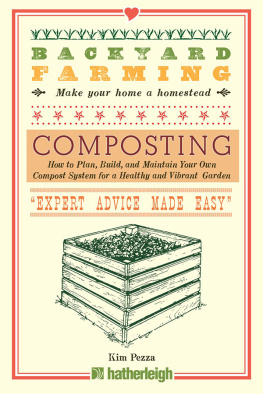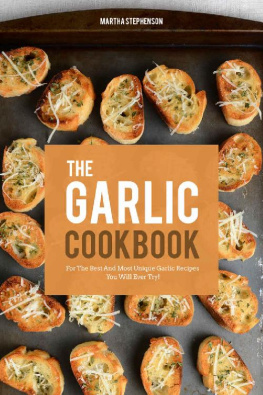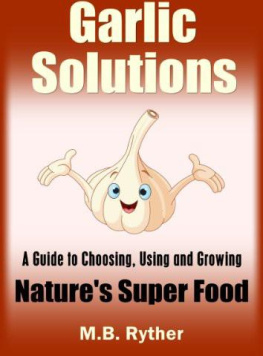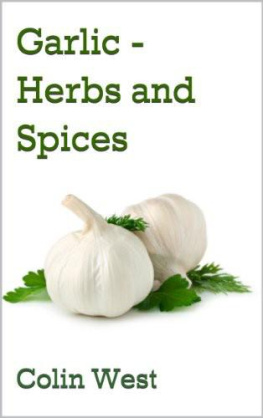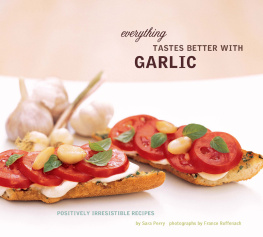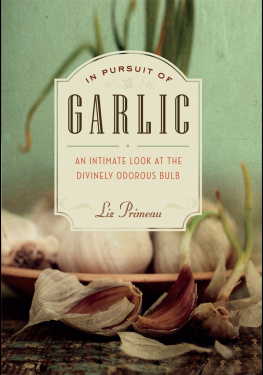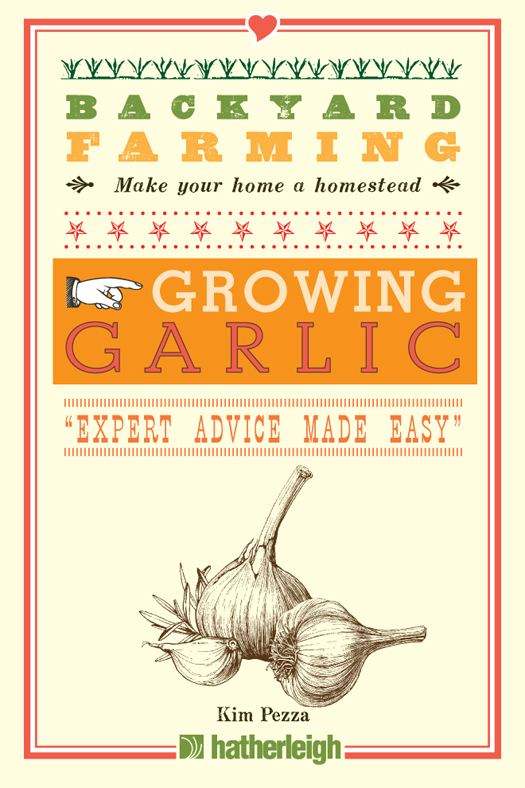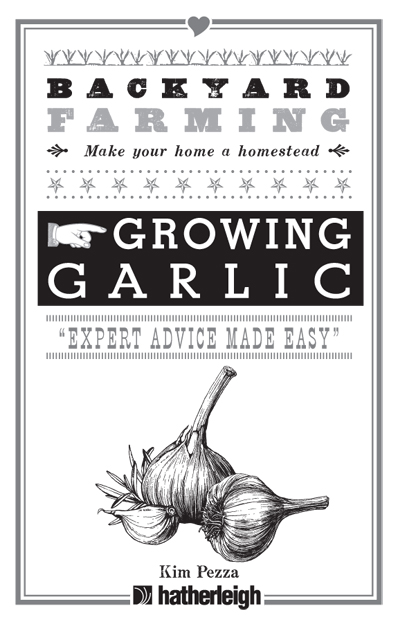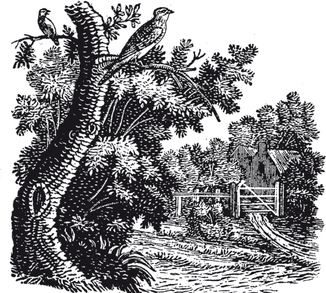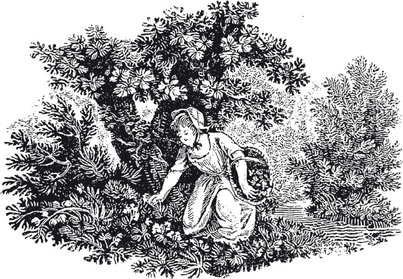
Hatherleigh Press is committed to preserving and protecting the natural resources of the earth. Environmentally responsible and sustainable practices are embraced within the companys mission statement.
Visit us at www.hatherleighpress.com and register online for free offers, discounts, special events, and more.
Backyard Farming: Growing Garlic
Text copyright 2014 Hatherleigh Press
Library of Congress Cataloging-in-Publication Data is available upon request.
ISBN: 978-1-57826-508-4
eBook ISBN: 978-1-57826-509-1
All rights reserved. No part of this book may be reproduced, stored in a retrieval system, or transmitted, in any form or by any means, electronic or otherwise, without written permission from the publisher.
Cover and Interior Design by Carolyn Kasper
v3.1
CONTENTS
INTRODUCTION
G arlic is perhaps one of the most well-known, well-loved, and frequently used spices in the world. But for all its popularity as a spice, it is considered to be a root vegetable, related to the onion family, all of which are part of the lily family.
Also called the stinking rose, a name that dates back to the Greeks and Romans, though the reason is not clear, garlic can be found in the culinary roots of many cultures, including Italian, Asian, Greek, French, Spanish, South American, and of course North American cuisine. It has played a part in forming traditions, legends, and lore, from being used in the mummification process to its use as a vampire repellent, as an element to ward off evil, and as being eaten by Roman soldiers for courage before a battle. It was even considered good luck in some cultures if one should dream about garlic in the home.
Today, garlic remains a favorite, not only for its strong flavor and versatility as a foodstuff, but for its health benefits as well. Toasted, roasted, braised, and sliced, we use garlic in a seemingly endless stream of recipes, handed down through the generations, even as we continue to create new menu options from scratch. It is available for purchase fresh from the farm or prepared in the grocery store as peeled, diced in oil or water, and powdered. We have even taken to growing it in our own vegetable, herb, and flower gardens, as garlic takes its place as part of the recent resurgence of home-grown foods.
Garlic has therefore remained a staple in many households. Just like salt and pepper, there are those who take garlic for granted in their daily menu plans, and do not even consider leaving garlic out of their spice rack. Over the course of the chapters that follow, youll have the chance to learn a little bit about this oh-so popular spice, including various growing techniques and new and exciting ways to use garlic in your daily life.
MEET THE EXPERT
Kim Pezza grew up among orchards and dairy and beef farms having lived most of her life in the Finger Lakes region of New York state. She has raised pigs, poultry and game birds, rabbits and goats, and is experienced in growing herbs and vegetables. In her spare time, Kim also teaches workshops in a variety of areas, from art and simple computers for seniors, to making herb butter, oils, and vinegars. She continues to learn new techniques and skills and is currently looking to turn her grandparents 1800s farm into a small, working homestead.
 CHAPTER 1
CHAPTER 1A BRIEF HISTORY OF GARLIC
E verything has its story, and garlic is no different. The word garlic originates from the Old English word garleac, which means spear leek. By contrast, the botanical name of garlic, Allium sativum, is thought to have come from the Celtic word all, meaning pungent. Originally native to central Asia, garlic is perhaps most recognized as being a staple in various Mediterranean dishes. This special vegetable, considered both a root vegetable and a spice, has actually been in use for over 7,000 years in a variety of places and cultures. Used for both culinary and medicinal needs, garlic is also one of the earliest-documented plants to be used for both general health needs as well as a treatment for disease. In other words, besides being used to treat specific illnesses, it was generally agreed upon that eating garlic was good for you, whether you were ill or healthy. Discussions about its uses have even been found in ancient medical books.
But there is more to this odd little root vegetable and spice package than meets the eye. Lets take a brief look at some of the history behind garlic, along with a bit of the folklore that goes with it.
Garlics Role in Ancient Times
In ancient times, garlics potent odor led many to believe that it was powerful in some way. The question was in what way. In some places, garlic was thought to be an aphrodisiac. But in central Europe it was said to ward off werewolves and vampires; it was thought that, by either wearing it on your person or hanging it on your door, you would keep away evil. In India as well, hanging garlic (along with red chili and lemon) was, and still is, believed to ward off evil when hung at the door. Even as far as the Philippines garlic was thought to drive away nearby monsters. But, in complete contrast, the Mongol Empire used garlic as currency.
You can find instances of people using garlic as far back in time as the pyramids themselvesand indeed, the root vegetable is still grown in Egypt today. In fact, garlic was worshiped by the ancient Egyptians and included in many of their most sacred of ceremonies, with preserved garlic even being found in the tomb of the pharaoh Tutankhamen. Garlic was also believed to both increase and maintain the strength of the kingdoms laborers, so much so that it became a daily staple of the laborer and working class diet.
In ancient Greece, soldiers would eat garlic with the belief that the spice would provide them with the courage they would need in battle. And they arent the only ones; soldiers in other ancient cultures participated in this practice as well. During the first Olympics, the athletes consumed garlic with the understanding that it would enhance their performance during the competitions. Garlic has also been found in Greek temples as well. As far as its health uses, Hippocrates and his fellows discussed the merits of garlic for treating respiratory and parasitic problems, and noted its use in aiding digestion difficulties. During the time of the Roman Empire, these experiments into the uses of garlic continued, as Neros army used garlic for cardiovascular cleansing, believing that garlic could clean the blood vessels. And yet, for all the uses it had (or was thought to have) by those in the ancient world, garlic was consumed primarily by the working class, notably in Greece, Egypt, and the Biblical Middle East. At around 2000 BC, garlic began to be used in China, which saw value in its consumption with raw meat. Garlic was also used in Chinese medicine.


